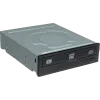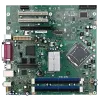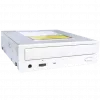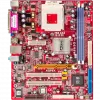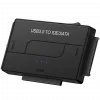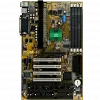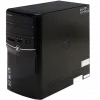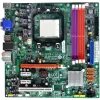Parallel ATA (PATA), originally ATA, is an interface standard for the connection of storage devices such as hard disks, solid-state drives, floppy drives, and optical disc drives in computers. The standard is maintained by X3/INCITS committee. It uses the underlying AT Attachment (ATA) and AT Attachment Packet Interface (ATAPI) standards.
The Parallel ATA standard is the result of a long history of incremental technical development, which began with the original AT Attachment interface, developed for use in early PC AT equipment. The ATA interface itself evolved in several stages from Western Digital's original Integrated Drive Electronics (IDE) interface. As a result, many near-synonyms for ATA/ATAPI and its previous incarnations are still in common informal use. After the introduction of Serial ATA in 2003, the original ATA was renamed Parallel ATA, PATA for short.
Parallel ATA cables have a maximum allowable length of only 18 in (457 mm). Because of this limit, the technology normally appears as an internal computer storage interface. For many years ATA provided the most common and the least expensive interface for this application. It has largely been replaced by Serial ATA (SATA) in newer systems.
The standard is originally conceived as "PC/AT Attachment" as its primary feature was a direct connection to the 16-bit ISA bus introduced with the IBM PC/AT. The "AT" in "IBM PC/AT" is an initialism for "Advanced Technology," but that term does not appear in current or recent versions of the ATA specification; it is simply "AT Attachment". This name was chosen to avoid possible trademark issues.
IDE and ATA-1
Example of a 1992 80386 PC motherboard with nothing built in other than memory, keyboard, processor, cache, realtime clock, and slots. Such basic motherboards could have been outfitted with either the ST-506 or ATA interface, but usually not both. A single 2-drive ATA interface and a floppy interface was added to this system via the 16-bit ISA card.
The first version of what is now called the ATA/ATAPI interface was developed by Western Digital under the name Integrated Drive Electronics (IDE). Together with Control Data Corporation (who manufactured the hard drive part) and Compaq Computer (into whose systems these drives would initially go), they developed the connector, the signaling protocols, and so on with the goal of remaining software compatible with the existing ST-506 hard drive interface. The first such drives appeared in Compaq PCs in 1986.
The term Integrated Drive Electronics refers not just to the connector and interface definition, but also to the fact that the drive controller is integrated into the drive, as opposed to a separate controller on or connected to the motherboard. The interface cards used to connect a parallel ATA drive to, for example, a PCI slot are not drive controllers, they are merely bridges between the host bus and the ATA interface. Since the original ATA interface is essentially just a 16-bit ISA bus in disguise, the bridge was especially simple in case of an ATA connector being located on an ISA interface card. The integrated controller presented the drive to the host computer as an array of 512-byte blocks with a relatively simple command interface. This relieved the mainboard and interface cards in the host computer of the chores of stepping the disk head arm, moving the head arm in and out, and so on, as had to be done with earlier ST-506 and ESDI hard drives. All of these low-level details of the mechanical operation of the drive were now handled by the controller on the drive itself. This also eliminated the need to design a single controller that could handle many different types of drives, since the controller could be unique for the drive. The host need only ask for a particular sector, or block, to be read or written, and either accept the data from the drive or send the data to it.
The interface used by these drives was standardized in 1994 as ANSI standard X3.221-1994, AT Attachment Interface for Disk Drives. After later versions of the standard were developed, this became known as "ATA-1".
A short-lived, seldom-used implementation of ATA was created for the IBM XT and similar machines that used the 8-bit version of the ISA bus. It has been referred to as "XTA" or "XT Attachment."
Second ATA interface
An Oak Technology Mozart 16 16-bit ISA sound card, from when the CDROM drive interface had not yet been standardized. This card offers four separate interface connectors for IDE, Panasonic, Mitsumi, and Sony CDROM drives, but only one connector could be used since they all shared the same interface wiring.
When PC motherboard makers started to include onboard ATA interfaces in place of the earlier ISA plug-in cards, there was usually only one ATA connector on the board, which could support up to two hard drives. At the time in combination with the floppy drive, this was sufficient for most people, and eventually it became common to have two hard drives installed. When the CD-ROM was developed, many computers would have been unable to accept these drives if they had been ATA devices, due to already having two hard drives installed. Adding the CD-ROM drive would have required removal of one of the drives.
SCSI was available as a CD-ROM expansion option at the time, but devices with SCSI were more expensive than ATA devices due to the need for a smart interface that is capable of bus arbitration. SCSI typically added US$ 100-300 to the cost of a storage device, in addition to the cost of a SCSI host adapter.
The less-expensive solution was the addition of a dedicated CD-ROM interface, typically included as an expansion option on a sound card. It was included on the sound card because early business PCs did not include support for more than simple beeps from the internal speaker, and tuneful sound playback was considered unnecessary for early business software. When the CD-ROM was introduced, it was logical to also add digital audio to the computer at the same time (for the same reason, sound cards tended to include a gameport interface for joysticks). An older business PC could be upgraded in this manner to meet the Multimedia PC standard for early software packages that used sound (which required the sound card) and colorful video animation (which required the CD-ROM as floppy disks simply did not have the necessary data capacity).
The second drive interface initially was not well-defined. It was first introduced with interfaces specific to certain CD-ROM drives such as Mitsumi, Sony or Panasonic drives, and it was common to find early sound cards with two or three separate connectors each designed to match a certain brand of CD-ROM drive. This evolved into the standard ATA interface for ease of cross-compatibility, though the sound card ATA interface still usually supported only a single CD-ROM and not hard drives.
This second ATA interface on the sound card eventually evolved into the second motherboard ATA interface which was long included as a standard component in all PCs. Called the "primary" and "secondary" ATA interfaces, they were assigned to base addresses 0x1F0 and 0x170 on ISA bus systems.
EIDE and ATA-2
In 1994, about the same time that the ATA-1 standard was adopted, Western Digital introduced drives under a newer name, Enhanced IDE (EIDE). These included most of the features of the forthcoming ATA-2 specification and several additional enhancements. Other manufacturers introduced their own variations of ATA-1 such as "Fast ATA" and "Fast ATA-2".
The new version of the ANSI standard, AT Attachment Interface with Extensions ATA-2 (X3.279-1996), was approved in 1996. It included most of the features of the manufacturer-specific variants.
ATAPI
As mentioned in the previous sections, ATA was originally designed for, and worked only with hard disks and devices that could emulate them. The introduction of ATAPI (ATA Packet Interface) by a group called the Small Form Factor committee (SFF) allowed ATA to be used for a variety of other devices that require functions beyond those necessary for hard disks. For example, any removable media device needs a "media eject" command, and a way for the host to determine whether the media is present, and these were not provided in the ATA protocol.
The Small Form Factor committee approached this problem by defining ATAPI, the "ATA Packet Interface". ATAPI is actually a protocol allowing the ATA interface to carry SCSI commands and responses; therefore all ATAPI devices are actually "speaking SCSI" other than at the electrical interface. In fact, some early ATAPI devices were simply SCSI devices with an ATA/ATAPI to SCSI protocol converter added on. The SCSI commands and responses are embedded in "packets" (hence "ATA Packet Interface") for transmission on the ATA cable. This allows any device class for which a SCSI command set has been defined to be interfaced via ATA/ATAPI.
ATAPI devices are also "speaking ATA", as the ATA physical interface and protocol are still being used to send the packets. On the other hand, ATA hard drives and solid state drives do not use ATAPI.
ATAPI devices include CD-ROM and DVD-ROM drives, tape drives, and large-capacity floppy drives such as the Zip drive and SuperDisk drive.
The SCSI commands and responses used by each class of ATAPI device (CD-ROM, tape, etc.) are described in other documents or specifications specific to those device classes and are not within ATA/ATAPI or the T13 committee's purview. One commonly used set is defined in the MMC SCSI command set.
ATAPI was adopted as part of ATA in INCITS 317-1998, AT Attachment with Packet Interface Extension (ATA/ATAPI-4).
UDMA and ATA-4
The ATA/ATAPI-4 also introduced several "Ultra DMA" transfer modes. These initially supported speeds from 16 MByte/s to 33 MByte/second. In later versions faster Ultra DMA modes were added, requiring a new 80-wire cable to reduce crosstalk. The latest versions of Parallel ATA support up to 133 MByte/s.
